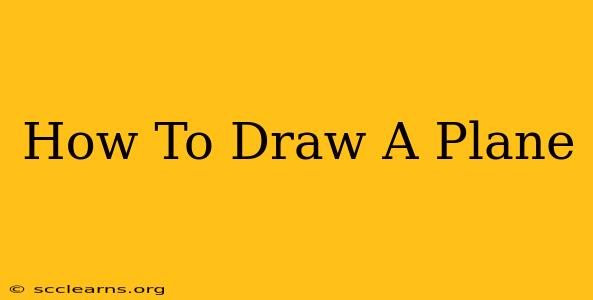So you want to learn how to draw a plane? Whether you're a seasoned artist looking for a new challenge or a complete beginner picking up a pencil for the first time, this guide will walk you through the process step-by-step. We'll cover everything from basic shapes to adding intricate details, ensuring you create a fantastic airplane drawing.
Getting Started: Gathering Your Supplies
Before we take flight, let's gather our materials. You'll need:
- Paper: Any drawing paper will do, but thicker paper is preferable to prevent smudging.
- Pencils: A range of pencils (e.g., HB, 2B, 4B) allows for varying line weights and shading. A mechanical pencil is also a great option.
- Eraser: A good quality eraser is essential for correcting mistakes. A kneaded eraser is particularly useful for lifting graphite without damaging the paper.
- Sharpener: Keep your pencils sharp for precise lines.
- Ruler (Optional): Helpful for achieving straight lines, especially for the plane's body.
Step-by-Step Guide to Drawing a Plane
This guide will focus on drawing a simple, recognizable airplane. More complex designs can be achieved by building upon these fundamental steps.
Step 1: The Fuselage - The Body of the Plane
Begin by sketching a long, slightly tapered oval. This will form the main body or fuselage of your airplane. Don't worry about making it perfect; it's just a guide.
Step 2: The Wings - Taking Flight
Draw two slightly curved rectangles extending from either side of the fuselage. These are the wings. The angle of the wings will influence the overall look of your plane. Experiment with different angles!
Step 3: The Tail - Stability and Control
Draw a vertical stabilizer (the fin) at the rear of the fuselage. This is the tall part of the tail. Add a horizontal stabilizer (the tailplane) extending from the back of the fuselage, usually positioned near the top and bottom of the vertical stabilizer.
Step 4: The Cockpit - The Pilot's View
Sketch a small, rounded rectangle or square near the front of the fuselage. This will be the cockpit where the pilot sits.
Step 5: Adding Details - Refining Your Design
Now it's time to add the finer details. This could include:
- Engines: Draw circular shapes under the wings or at the rear of the fuselage, depending on the plane design.
- Propeller (for propeller planes): Add a propeller at the front of the engine. Use simple lines to create the blades.
- Windows: Sketch small rectangles on the cockpit and potentially along the fuselage.
- Landing Gear: Draw simple shapes for the wheels under the wings or fuselage.
Step 6: Shading and Finishing Touches - Bringing Your Plane to Life
Once you're happy with the basic shape, start adding shading. This will add depth and realism to your drawing. Use darker pencils to create shadows and highlights to give your plane a three-dimensional look. Experiment with different shading techniques to achieve the desired effect. Erase any unwanted guidelines.
Different Types of Planes - Expanding Your Horizons
Once you've mastered the basics, try drawing different types of aircraft, such as:
- Fighter jets: These are characterized by sleek designs and sharp angles.
- Passenger jets: These are typically larger with wider wings and multiple engines.
- Helicopters: These require a different approach, focusing on the rotor blades and the fuselage.
Tips and Tricks for Success
- Practice makes perfect: The more you practice, the better you'll become.
- Start simple: Begin with basic shapes before adding details.
- Use light strokes: This allows you to easily erase and adjust your drawing.
- Observe real airplanes: Study photos and videos of airplanes to understand their shapes and proportions.
- Don't be afraid to experiment: Try different styles and techniques.
Drawing a plane can be a rewarding experience. So grab your pencils, let your imagination take flight, and enjoy the process! Remember to share your creations – we'd love to see them!

